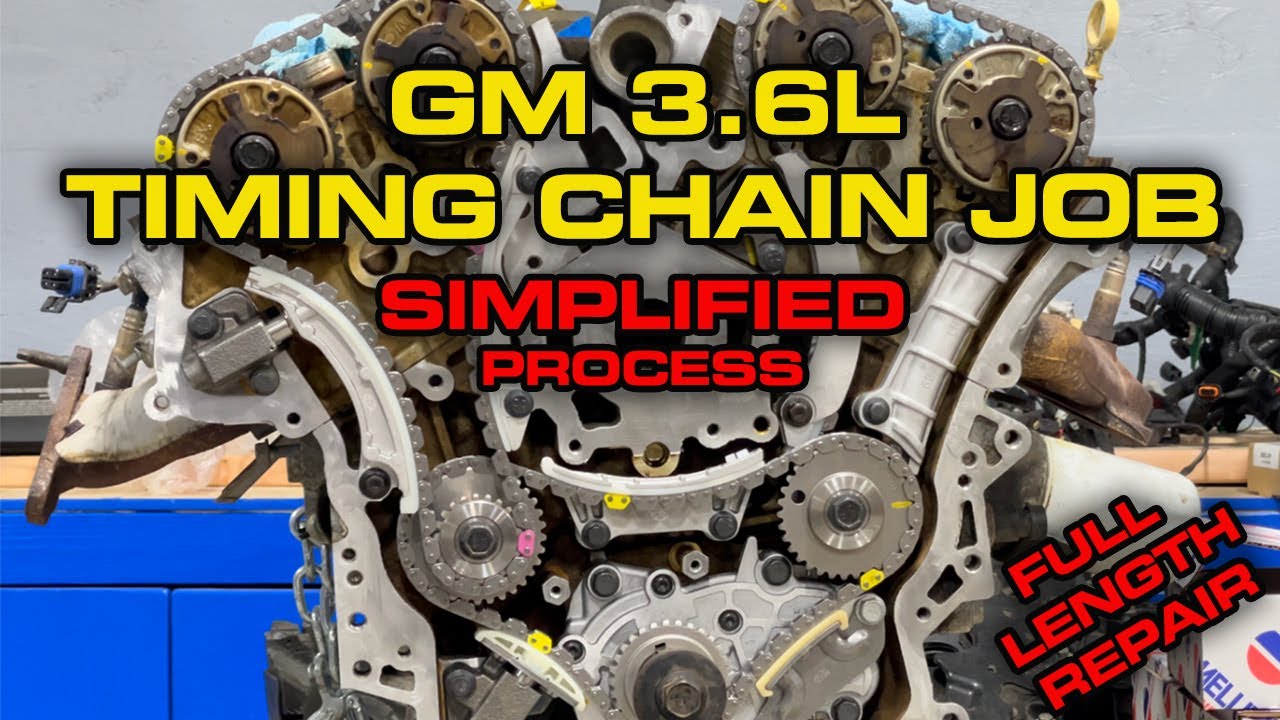Decoding the GM 3.6 Timing Chain: A Deep Dive
Ever feel like your car is speaking a language you just don't understand? Like, it's making this *clatter* and you're pretty sure it's not supposed to, but figuring out why feels like deciphering ancient hieroglyphs? Well, if you're dealing with a GM 3.6L engine, that clatter could be coming from its timing chain, and understanding its schematic is key.
The GM 3.6L V6 engine, a workhorse found in many popular vehicles, relies on a timing chain to orchestrate the precise dance between pistons and valves. This chain, a crucial component of the engine's internal timing, ensures everything works in harmony. But what happens when this harmony is disrupted?
Visualizing the layout of this system can be incredibly helpful, especially when troubleshooting. A GM 3.6 timing chain diagram provides a visual roadmap of how everything connects, from the crankshaft to the camshafts, guiding the intricate timing of the engine's internal components. Understanding this diagram is like having a backstage pass to your engine’s performance.
Think of the timing chain like the conductor of an orchestra. It keeps everything synchronized, ensuring the valves open and close at precisely the right moment to allow the engine to breathe and combust fuel efficiently. Without proper timing, the performance suffers, and you might experience anything from a rough idle to catastrophic engine failure.
This detailed exploration of the GM 3.6 timing chain system will equip you with the knowledge you need to understand its importance, diagnose potential problems, and maintain it properly. We’ll delve into its intricacies, address common issues, and provide valuable insights for keeping your engine running smoothly.
The GM 3.6L engine, first introduced in the mid-2000s, features a dual overhead cam (DOHC) design with variable valve timing (VVT). The timing chain system, responsible for synchronizing the crankshaft and camshafts, became a focal point due to reports of premature wear and stretching in some early iterations of the engine. Subsequent revisions addressed these concerns, but understanding the system remains crucial for proper maintenance.
The GM 3.6 timing chain diagram depicts the chain's path, connecting the crankshaft sprocket to the camshaft sprockets, as well as the tensioners and guides that maintain proper chain tension. This diagram is essential for understanding the relationship between these components and diagnosing potential problems. Without this synchronization, the engine wouldn't function correctly.
One benefit of a chain-driven system is its durability compared to older timing belt systems. Timing chains are generally more robust and less prone to sudden failure. Another advantage is the precise control over valve timing, especially with VVT systems, which allows for optimized performance and fuel efficiency.
Common issues associated with the GM 3.6 timing chain include stretching, tensioner failure, and guide wear. These problems can lead to a range of symptoms, from a rattling noise at startup to engine misfires and performance loss.
Troubleshooting timing chain issues often involves listening for unusual noises, checking for diagnostic trouble codes, and inspecting the chain and related components. Consulting a qualified mechanic is recommended for accurate diagnosis and repair.
Advantages and Disadvantages of Timing Chains
| Advantages | Disadvantages |
|---|---|
| Durability | Complexity |
| Precise Timing Control | Potential for Noise |
| Lower Maintenance (compared to belts) | Higher Repair Costs (if failure occurs) |
Best practices for maintaining the GM 3.6 timing chain include regular oil changes with the correct oil viscosity, listening for unusual engine noises, and addressing any timing-related diagnostic codes promptly.
Frequently Asked Questions about the GM 3.6 Timing Chain:
1. What are the symptoms of a failing timing chain? (Rattling noise, engine misfires, performance loss)
2. How often should the timing chain be replaced? (Typically lasts the life of the engine with proper maintenance)
3. Can I replace the timing chain myself? (It's a complex job best left to experienced mechanics)
4. What is the cost of timing chain replacement? (Varies depending on the vehicle and labor rates)
5. How can I prevent timing chain problems? (Regular maintenance, using the correct oil)
6. What is the function of the timing chain tensioner? (Maintains proper chain tension)
7. What are the symptoms of a failing timing chain tensioner? (Similar to a failing timing chain)
8. Where can I find a GM 3.6 timing chain diagram? (Repair manuals, online forums)
Tips and tricks for dealing with GM 3.6 timing chain issues include paying close attention to any unusual engine noises and consulting a qualified mechanic promptly if any concerns arise. Early diagnosis and intervention can prevent more serious and costly damage.
In conclusion, the GM 3.6L engine's timing chain system, while complex, is vital for proper engine operation. Understanding its function, potential problems, and maintenance requirements can help you keep your engine running smoothly for years to come. Regular maintenance, including oil changes and attentive listening for unusual noises, is key to preventing costly repairs. While accessing and understanding a GM 3.6 timing chain diagram is crucial for visualizing the system and troubleshooting, consulting a qualified mechanic is always recommended for any significant repairs or concerns. By proactively addressing potential issues and prioritizing regular maintenance, you can ensure the longevity and performance of your GM 3.6L engine. Don't let a little clatter turn into a major headache – stay informed and keep your engine purring like a kitten. (Or at least, as smoothly as a well-oiled machine.)
Unraveling amelia shepherd a greys anatomy deep dive
Kim sun young beauty salon the ultimate guide to hair perm salons
Navigating workplace disputes understanding eeoc mediation













